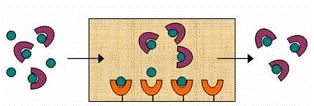Department of Chemistry
Document Type
Article
Date of this Version
5-2007
Citation
Published in final edited form as: J Chromatogr A. 2007 May 18; 1149(2): 294–304. Version presented here is from NIH PubMed Central.
Abstract
An affinity monolith based on silica and containing immobilized α1-acid glycoprotein (AGP) was developed and evaluated in terms of its binding, efficiency and selectivity in chiral separations. The results were compared with data obtained for the same protein when used as a chiral stationary phase with HPLC-grade silica particles or monoliths based on a copolymer of glycidyl methacrylate (GMA) and ethylene dimethacrylate (EDMA). The surface coverage of AGP in the silica monolith was 18% higher than that obtained with silica particles and 61% higher than that measured for a GMA/EDMA monolith. The higher surface area of the silica monolith gave materials that contained 1.5- to 3.6- times more immobilized protein per unit volume when compared to silica particles or a GMA/EDMA monolith. The retention, efficiency and resolving power of the AGP silica monolith were evaluated by injecting two chiral analytes onto this column (i.e., R/S-warfarin and R/S-propranolol). In each case, the AGP silica monolith gave higher retention plus better resolution and efficiency than AGP columns containing silica particles or a GMA/EDMA monolith. The AGP silica monolith also gave lower back pressures and separation impedances than these other materials. It was concluded that silica monoliths can be valuable alternatives to silica particles or GMA/EDMA monoliths when used with AGP as a chiral stationary phase.



Comments
Copyright Elsevier Inc. Used By Permission.